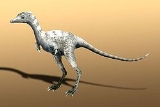
Ceratonykus
Encyclopedia
Ceratonykus is a genus
of alvarezsaurid
theropod dinosaur
that existed in the late Cretaceous
period. The discovery of a fragmented skeleton in Mongolia
in early 2009 has led scientists to question where alvarezsaurids fit taxonomically into Theropoda.
Originally thought to be one of the earliest members of flightless bird
s, alvarezsaurids have recently been regarded as more basal
theropods. Skeletal remains suggest that they had tiny but stout forelimbs and compact birdlike hands. The skeletal structure also suggests that this dinosaur possessed significant breast and arm muscles that were likely adapted for tearing and digging. They had elongate jaws with minute teeth and a tubular snout that suggests they could have been adapted to feed on insects such as termites.
Genus
In biology, a genus is a low-level taxonomic rank used in the biological classification of living and fossil organisms, which is an example of definition by genus and differentia...
of alvarezsaurid
Alvarezsauridae
Alvarezsauridae is an enigmatic family of small, long-legged running dinosaurs. Although originally thought to represent the earliest known flightless birds, a consensus of recent work suggests that they are primitive members of the Maniraptora. Other work found them to be the sister group to the...
theropod dinosaur
Dinosaur
Dinosaurs are a diverse group of animals of the clade and superorder Dinosauria. They were the dominant terrestrial vertebrates for over 160 million years, from the late Triassic period until the end of the Cretaceous , when the Cretaceous–Paleogene extinction event led to the extinction of...
that existed in the late Cretaceous
Cretaceous
The Cretaceous , derived from the Latin "creta" , usually abbreviated K for its German translation Kreide , is a geologic period and system from circa to million years ago. In the geologic timescale, the Cretaceous follows the Jurassic period and is followed by the Paleogene period of the...
period. The discovery of a fragmented skeleton in Mongolia
Mongolia
Mongolia is a landlocked country in East and Central Asia. It is bordered by Russia to the north and China to the south, east and west. Although Mongolia does not share a border with Kazakhstan, its western-most point is only from Kazakhstan's eastern tip. Ulan Bator, the capital and largest...
in early 2009 has led scientists to question where alvarezsaurids fit taxonomically into Theropoda.
Description
Ceratonykus was a small, long-legged dinosaur that appears to have been be adapted for running in the desert. They belong to the family Alvarezsauridae, whose members ranged in size from 0.5–2 m (20–80 inches) in length, but may have been significantly larger - 2.5 m (8 ft).Originally thought to be one of the earliest members of flightless bird
Bird
Birds are feathered, winged, bipedal, endothermic , egg-laying, vertebrate animals. Around 10,000 living species and 188 families makes them the most speciose class of tetrapod vertebrates. They inhabit ecosystems across the globe, from the Arctic to the Antarctic. Extant birds range in size from...
s, alvarezsaurids have recently been regarded as more basal
Basal (phylogenetics)
In phylogenetics, a basal clade is the earliest clade to branch in a larger clade; it appears at the base of a cladogram.A basal group forms an outgroup to the rest of the clade, such as in the following example:...
theropods. Skeletal remains suggest that they had tiny but stout forelimbs and compact birdlike hands. The skeletal structure also suggests that this dinosaur possessed significant breast and arm muscles that were likely adapted for tearing and digging. They had elongate jaws with minute teeth and a tubular snout that suggests they could have been adapted to feed on insects such as termites.

